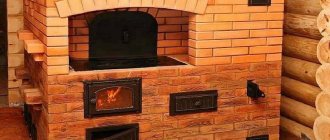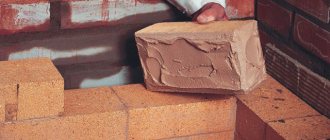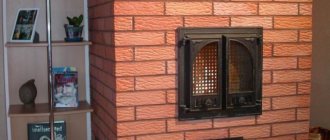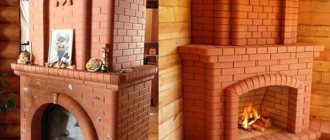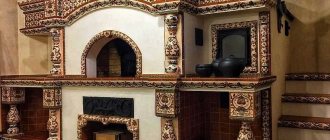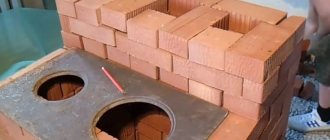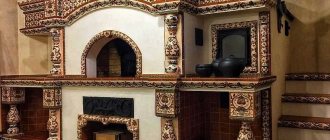Kuznetsov Igor Viktorovich (Ekaterinburg) - specialist in the design and laying of brick kilns. Kuznetsov’s kilns are known not only in our homeland, but by many foreign specialists and lovers of brick kilns. Moreover, they not only know about them, but also very often order projects. Orders come from such “advanced” countries in the furnace business as Canada, Finland, USA, Sweden.
The uniqueness of Kuznetsov furnaces is that the efficiency of some models exceeds 80%, while the best foreign projects give a little more than 60%. Such high efficiency of thermal energy use is achieved thanks to two hoods in one furnace. The cap is a brick vault, closed or with a hole for the escape of gases, which is supported by brick columns. To save space, in some stove models, the second hood is located above the first; they are connected by a chimney or channels through which heated air moves.
This system allows you to maintain a stable high temperature (900-1200°C) in the lower bell for a long time, which makes it possible to completely burn out any fuel. In Kuznetsov furnaces, any fuel burns to ash in any weather. In this case, there is no need to strongly manipulate the dampers. They are used more often to provide non-standard operating modes.
In the upper bell, the temperature is much lower (200-400°C), which makes it possible to install heat exchangers and tanks for water and stones there without the risk that they will soon burn out. The division of the internal space of the furnace into two almost isolated zones is also good because the heat consumption for heating the water/stones at the top does not affect the weather in the lower hood - it remains high there.
Kuznetsov furnaces. Air movement design features
Kuznetsov sauna stoves
There are many different designs of Kuznetsov stoves.
Many furnaces of different sizes and purposes have been created. There are 17 varieties of standard Kuznetsov sauna stoves (BIK). To these you need to add two varieties of BIC BC, 14 options of BIC PC. What is the difference? The size, location of the firebox, stone oven, presence or absence of a fireplace, hob and some other features. There are Kuznetsov sauna stoves with a remote tank or a built-in one, and Kuznetsov sauna stoves for black-style saunas or with an open heater. In fact, there are so many of them that you can choose a more or less suitable stove from ready-made ones, if necessary, modifying it a little to suit your bathhouse. Kuznetsov furnaces. Diversity
Why are Kuznetsov’s sauna stoves popular? There are many reasons for this:
- They are practically omnivorous. Any fuel burns to ash in them. And if it is not recommended to heat a bathhouse with any “left” fuel other than firewood, then any type of fuel will be suitable for heating a house.
- Such efficient combustion of fuel makes BIR very economical, while not only the bathhouse is heated, but also water (up to 170 liters) and stones.
- Even when using low-quality fuel, little soot is formed. If you heat with good dry wood (after all, you choose the best for a bath), you need to clean the stove much less often than stoves of other designs under similar operating conditions.
- The oven heats up evenly due to which, firstly, the heat is retained for a long time, and secondly, cracks rarely appear.
- Kuznetsov's sauna stoves not only prepare a sauna and keep it warm for a long time. They dry the room after the procedure. All this is thanks to the high heat capacity. At the same time, the next day the water in the tank remains warm enough to swim in.
- Long service life is guaranteed with a minimum of iron parts. The whole point is that there is too much difference in temperature expansion: metal parts expand much more, as a result, cracks appear in the masonry around them.
Types
Stove equipment for baths can be divided into groups depending on various factors - the type of fuel used, the material from which the unit is made.
By material
Depending on the material, there are two types of structures:
- Brick. Standard stoves for Russian baths. They retain heat for a long time, but take a long time to heat up.
- Metal. The structures can be purchased in specialized stores or assembled yourself. Allows you to quickly warm up bath rooms. Metal burns out over time due to exposure to high temperatures.
The choice of stove depends on the amount of free space in the bathhouse, financial capabilities, the presence of a separate base, and the necessary technical characteristics.
By fuel type
Depending on the type of fuel, there are 3 types of designs:
- Gas. The least popular models, since connection to the central gas supply system is not always available. Using cylinders is inconvenient; only specialists with certain permits can connect gas equipment.
- Electrical. When using such equipment, there is no need to arrange and clean the chimney. You can precisely regulate the temperature.
- Wood-burning. They work from any type of firewood or briquettes made from compressed sawdust.
The principle of operation of the Kuznetsov furnace
Kuznetsov proposed a completely new approach to building a brick oven. As you know, traditionally designed kilns have channels through which hot gases move, heating the brick. The main factor supporting this process is traction. This forced method of heating the furnace body is characterized by uneven heat distribution. In addition, it often leads to the formation of cracks in the walls of the structure. When building such a stove, which takes up quite a lot of space in the room, a lot of bricks are used.
The question also arises regarding the availability of space for installing a heat exchanger. This device loses the service life specified by the manufacturer if it is placed in the firebox itself. Constant contact with fire has a detrimental effect on the strength characteristics of the heat exchanger. This proximity also leads to deterioration of fuel combustion conditions, a decrease in the efficiency of the furnace and the formation of a large amount of soot.
In a furnace built according to the Kuznetsov method, gases move freely.
Scheme of operation of the Kuznetsov bell furnace
This design is based on the installation of caps inside it, which are vessels turned upside down. On some stove models, the hoods may have top holes. The vessels are located in different orders, but the main condition for their placement is the presence of vertical void gaps between them, called a dry seam. The space thus formed, up to 3 cm wide, is not filled with either a heat insulator or a solution. As a result, gases move freely, moving from one bell jar to another.
To more easily imagine the operation of the Kuznetsov bell furnace, you need to visualize in your imagination a fire lit in the open air. As a result of the fact that the air has unlimited access to the flame, little heat comes from the fire, which is immediately dissipated in space. You can change the nature of the process of heating the air around the fire if you cover it with a bell-shaped vessel, for example, a large cauldron
At the same time, it is important to leave a gap at the bottom so as not to completely extinguish the flame. As a result, hot gas naturally rises to the bottom of the cauldron and limits the access of air coming from outside
After the heat is transferred to the walls of the vessel, it, going down to the open opening, gradually cools and comes out, and its place is taken by the next portion of heat.
This self-regulating process is characterized by the possibility of dosing outside air and keeping the heated gas in the vessel until it cools completely.
Scheme of operation of the Kuznetsov bell furnace
The principle described above is used in Kuznetsov furnaces, for which two hoods are used at once, connected by a dry seam. This non-standard design helps to increase the efficiency of transferring a sufficient amount of heat from the stove to the room where it is installed. Hot gases first fill the first bell, thereby heating its walls, and then, cooling, give way to a hot flow that rises from the furnace.
Trying to optimize this process, the inventor, even at its first stage, which begins after the firebox, decided to divide the flow of gases in accordance with their temperature. For this purpose, he used a partition to separate the hood space from the firebox. In this case, the barrier does not reach the bottom of the vessel. As a result of this separation, hot gases immediately rush to the roof of the bell, and a flow of lower temperature is directed along the dry seam through a gap in the partition. Thus, due to the accumulation of hot gases under the roof and the presence of a barrier, air enters the first hood only in the required quantity. This promotes complete combustion of the fuel with the formation of a certain amount of ash.
A similar process of gas movement occurs in the cap installed above the first one.
Drawing of the Kuznetsov bell furnace
Less hot combustion products are placed at the bottom of the vessel, and hot gases tend to the roof and, when cooled, transfer heat to the brick walls. Then they go down and out through the chimney. By equipping the stove with two hoods, in which natural injection and movement of gases occurs, the creation of forced draft in the chimney pipe is not required.
Construction options
Heating and cooking stoves for domestic use can be of several types according to their design.
Chamber
A metal chamber stove is a classic “potbelly stove”, which has been greatly improved in modern production. This unit has the following technical characteristics:
Channel
The principle of operation of this design: the gases burn out, and then cool and pass through the channels between the partitions, and give off heat to the furnace body. The unit must warm up to 400°C inside - then afterburning will occur in it. Modern potbelly stoves can easily be reclassified as a duct circuit. In this case, only a horizontal “elbow” is left from the flue and it separates the combustion chamber from the firebox.
Combustion air enters through the cracks of the hob or through a special air throttle. A duct stove has an efficiency of up to 80%, and the specific thermal power is several times greater than that of a chamber stove. Such a stove works both with long burning and with flame, on almost any fuel.
At the same time, the power is regulated by the air supply - this possibility here is 2 times higher than in a chamber potbelly stove. An advantage for household use is the temperature in the afterburner is within 250-300°C, and this is convenient for cooking.
Almost all metal household stoves with a power of up to 15 kW are created according to the scheme described above. The body is usually made of ordinary steel with a thickness of 4 mm or more, and the hob is made of cast iron or steel with a thickness of 8 mm or more.
Kolpakovaya
Finally, a bell furnace is a scheme in which gases are retained by the roof of the bell until complete combustion, and then they fall down and give off the remaining heat. Such designs provide more than 70% efficiency. This technology is also applicable to metal boilers, but here we had to abandon the flame - a metal cap simply will not absorb as much heat as it releases without overheating. Therefore, such stoves were switched to smoldering mode - this made it possible to increase the heat transfer time to 60 hours (with wood) or up to 30 days (with coal).
Long-burning metal stoves can be made with your own hands and operate on wood, coal, but not on wet fuel, since wet fuel does not smolder, no matter how much air you give it. If this is a special coal boiler, then it will not be able to work on wood - it simply will not “give out” the required efficiency. The body of such a boiler is made of simple steel, surrounded by a sealed gas jacket.
Construction of a Kuznetsov furnace with your own hands
Diagrams and drawings of brick stoves - correct masonry The sequence of actions is as follows:
First, they study the floor plan of the room where the heating device is planned to be installed. In the case when the house is not built, it is necessary to ensure uniform heating of all rooms. It is not advisable to install a heating unit into a finished building, but if necessary, you can
But at the same time, you should take into account the location of the supporting structures and beams when arranging the chimney. Then the foundation for the heating device is prepared. It is made of concrete, and the width should be 10 centimeters greater than the size of the device
It is advisable to design the foundation for the stove at the house planning stage.
Types of Kuznetsov stoves
Based on the functions they perform, Kuznetsov’s brick kilns can be divided into several main groups:
- Heating.
Their main task is to heat rooms. - Cooking.
They are used for cooking. This group also includes bread ovens and stoves adapted for cauldrons.
Bathhouses. The principle of operation of Kuznetsov’s bathhouse stoves remains unchanged - the natural movement of gases through two bells. Another thing is that there is a heater here, which needs to be heated thoroughly to obtain high-quality steam. The developer proposed and is still using an optimal technical solution, where the stone backfill is placed in an oven made of heat-resistant steel. The oven is located directly above the firebox. The thermal energy accumulated in the lower and upper hoods is used to heat water and heat not only the steam room, but also all adjacent rooms. The water coil is installed under the first hood so that it can be easily repaired or replaced. The installation location can be determined by studying the drawings of the furnaces.
- Fireplaces.
- Grills and barbecues.
- Combined structures, complexes.
- Perhaps the most popular are Kuznetsov’s heating and cooking stoves. They will warm the house and won’t leave you hungry.
The heating and cooking option is most in demand by both summer residents and residents of rural areas. There is a simple practicality here: if you already have a fire, why not use it additionally for cooking.
Kuznetsov also has such projects.
Before you start building, make sure that this is exactly the option that you want to see in your home.
Such stoves imply the presence of a convenient ledge with a cast-iron surface, with the possibility of partially opening the holes to increase the temperature. It is also possible to make a door for a cauldron, similar to ancient Russian stoves.
The layout of heating and cooking stoves requires its own approach and individual drawings.
Bell furnaces can be erected in almost any room. This could be an apartment, a residential building, an outbuilding or a bathhouse. For example, for a bathhouse, a bell-type stove will be an ideal replacement for an ordinary standard stove.
By building this sauna stove, you can solve several problems at once. This design is capable of heating several rooms: a sink and a steam room, as well as a relaxation room. In addition, it is very convenient to heat water on the stove, simultaneously creating steam in the required quantity.
The house can be equipped with two-bell heating using a stove; this installation is very functional. Before erecting such a structure, it is necessary to carefully study the project.
A system that burns raw fuel must be organized in the most optimal way. The furnace must always be maintained at the correct temperature, otherwise the gases that are formed after combustion can be transformed into harmful waste soot and tar.
Water-heated stoves
Modern Kuznetsov stoves with water heating of the KIK series (brick boilers) are of particular interest. Essentially, this is a bell-type boiler, made of brick and has a good efficiency - about 70-80%, that is, similar to its iron “brothers”. How such high efficiency is achieved was described above.
1 or 2 registers made of steel pipes are built into the body of the furnace (depending on power). Ready-made boiler modifications have a range of capacities of 17, 34 and 63 kW. In addition, the author also offers dual-circuit models with the ability to heat water for household needs. In his recommendations for the construction of such heaters, I.V. Kuznetsov points out that to increase the efficiency and efficiency of operation, the body of a brick boiler should be insulated with basalt fiber.
Most dome furnace models have a modern technical solution that ensures afterburning of the combustible component of flue gases. For this purpose, a secondary air supply is organized under the arch of the upper hood or another place, depending on the design. When using wood of appropriate quality, such a heating device will function as a pyrolysis furnace.
A little theory
Traditional home stoves with hobs, “Dutch” and “Swedish”, despite their design differences, are united by one common feature. It affects the efficiency of these heating appliances - this is the natural draft of the chimney. Without draft, none of the majority of known stoves will function; solid fuel boilers are not far behind in this regard.
Let’s make a reservation: none, except Kuznetsov’s, because only the brainchild of Igor Vladimirovich does not require natural traction for its work.
The secret of efficient operation, which distinguishes Kuznetsov’s two-bell furnaces from all others, lies in the principle of free flow of gases, which does not require additional external energy.
This theory is described in great detail and in an accessible way in articles posted by the inventor on the pages of his own web resource www.stove.ru. There are also publicly available designs of furnaces that have already been put into operation. We will look at the theory briefly, comparing the traditional method of burning solid fuels with the processes occurring in a bell furnace. So, in a conventional or duct stove of the “Dutch” type, the movement of air and combustion products is due to the presence of draft in the chimney pipe.
Natural craving is an external factor that acts depending on:
- height difference between the entrance to the ash pit and the upper section of the pipe;
- differences in temperatures of outside air and flue gases;
- wind load.
That is, the draft is present even when the heater is inactive, as long as the damper is open. In the operating mode of the furnace, the draft increases many times, the speed of the gases increases sharply. As a result, a lot of air enters the firebox, the combustion temperature drops, and the efficiency of wood burning decreases. By limiting the access of air with a damper, we force the fuel to smolder with a lack of oxygen, which is also not the optimal mode for extracting thermal energy from wood.
A proper stove with high efficiency should remove maximum heat from combustion products so that it does not fly out into the chimney. In practice, this is not so easy to implement and here's why:
- when the damper is open, hot gases quickly move through the brick channels, not having time to transfer heat to the walls;
- if the damper is closed, the flow speed will decrease, but the material of the channels is not able to absorb all the generated heat and transfer it into the room, so some of the energy still flies out into the pipe.
For these reasons, the efficiency of use of almost all existing furnaces rarely reaches 60%. Kuznetsov's developments successfully solved both problems; the efficiency of fuel combustion and the efficiency of using the released heat are about 80%. Not every boiler operating on solid fuels can produce such an indicator. I.V. Kuznetsov outlined the basics of designing furnaces in accordance with the principle of free flow of gases, which we will consider below.
Which stove is better: bell-type or channel?
Not all types of stoves were originally made to provide heat to a home. For example, the first development and application of “blacksmithing” was in metallurgy. Due to its high productivity and rapid heating of the surface, it was very successfully used in ore smelting. Channel-type structures were initially adapted for domestic needs and their primary tasks were: supplying the room with heat and preparing food. Given these features, many users constantly wonder: which of the two variations is better?
In order to answer this question, we note the main technical indicators, pros and cons of both furnaces.
Channel furnace. The operating principle of such a device is to move heated air from the firebox to the smoke exhaust system. The disadvantage of this process is the formation and release of a large amount of smoke during kindling. This is due to the fact that draft occurs only if the channel is well heated. Another disadvantage is that the chimney pipe must be high.
Bell furnace. This stove operates on the principle of natural circulation of heated air masses. Hot air rises up and is directed into the hood, gives off heat to the walls and descends to the lower part of the structure, into the smoke exhaust system through the vents. As already noted, models with several caps are also available, which are even more productive. The advantage of such a stove is that it does not need to be heated to ensure normal functioning. The chimney pipe can be located lower, the surface heats up as quickly as possible, but not as evenly as in a channel stove.
https://youtube.com/watch?v=tpqzcNvB3ik
Thus, the Kuznetsov bell-type stove is a good option for heating a house or bathhouse, and also provides the opportunity to cook food.
Necessary materials
Before starting construction, you need to buy all the required materials and prepare the necessary tools in order to stop construction.
Fire brick
Materials for the construction of the furnace:
- refractory brick - for the construction of a firebox;
- fireproof mastic – for the firebox;
- ceramic brick (grade minimum m150);
- cement, sand and clay - to create the base and brickwork;
- wooden material - for formwork;
- wooden blocks 50x50 - installed in the corners for even masonry;
- metal corners, fittings, wire, plates;
- special foil for the base;
Tools for the construction of “Kuznetsovka”:
- drill with a whisk for mixing the solution;
- shovel and bayonet;
- Master OK;
- large or small grinder;
- large building level;
- roulette;
- bushhammer;
- container for solution;
- saw (hand or electric saw).
This is what the minimum set of tools will look like, without which it will not be possible to achieve the desired result.
To arrange a brick “blacksmith’s shop” for a house or bathhouse, first of all, you should prepare working drawings and procedures. The author himself has developed over a hundred different stoves with step-by-step instructions for their construction.
The order of the stove is a complete guide that clearly explains the correctness of laying each individual row in the prescribed sequence. Beginning craftsmen are advised to strictly follow the order of Kuznetsov furnaces, which will allow them to build a reliable and durable structure.
To carry out construction work, it is necessary to prepare basic materials and working tools:
- solid red fire-resistant brick;
- fireclay brick;
- fire-resistant clay of medium fraction;
- mountain sand (twice the volume of clay);
- steel wire;
- metal corner;
- structural elements: doors for the ash pit, fireboxes, grate for the grate, valve, stove for the hearth.
Do-it-yourself Kuznetsov stoves have their own subtleties of construction, so before starting work, the layout of the device must be carefully studied.
Kuznetsov furnace made of metal
Kuznetsov stoves can be installed in small spaces. To fit such a unit in small rooms, it is necessary to reduce its dimensions. This leads to a significant decrease in productivity, which negatively affects the efficiency of the entire heating system.
To rid the bell-type stove from this drawback, it is recommended to make it from metal. In this case, it is not advisable to use cast iron. It is not only fragile, but also quite heavy. It is preferable to make the body of the unit from steel and treat it with powder paint. The high strength and reliability of steel bell-type models is ensured by the absence of large shear loads.
The only problem with the Kuznetsov steel furnace is the design of the arch of the first bell. It is in this place that exhaust gases, which have a high temperature, collect. It is quite difficult to make the lining of such stoves, especially if they are characterized by small dimensions. Therefore, brick bell-shaped models will never lose their relevance.
More about round ones
Round stoves theoretically have a lot of advantages, but they are not very convenient in the house. However, there is also a significant demand for compact mobile ovens, and here the extremely high efficiency of round multi-caps can be a decisive factor, because when the size of the oven decreases, its efficiency drops sharply due to the square-cube law.
Such furnaces, of course, would have to be made of metal. This solves the problem of cleaning; the stove can be made collapsible. But the choice of metals suitable for the ratio of heat capacity and thermal conductivity is extremely limited. The only inexpensive ones are cast iron, but it is heavy and fragile.
However, there is a lighter and stronger metal material with similar properties. These are products of powder metallurgy. In relation to scissor knives, “powdered crap” is quite justified, but for a stove in which nothing works for shear, powdered parts can be a godsend.
The second problem, which has already been mentioned, is the heat-resistant lining on the arch of the first cap. If it can be solved, then perhaps the works and efforts of Igor Viktorovich Kuznetsov will bear fruit that is more extensive and significant than it now seems.
Below you can share your thoughts and results with our readers and regular visitors.
You can also ask questions to the author*, he will try to answer them.
Types of furnaces
The cap has been used as an element of the channel system for quite some time. In different versions, from a brick vault in a furnace to a cast iron slab or backfilled with stone. The simplest bell-type sauna stove may have a built-in steel or copper vault, which significantly improves the conditions for the movement of hot gases.
An additional cavity can be built over the firebox for better heating of stones or a built-in water tank.
Kuznetsov’s brick sauna stoves differ from the classic versions of fireboxes with a hood in three conditions:
- In the design of the hood, the afterburning of unburnt gases necessarily occurs, so Kuznetsov bathhouse stoves always have a high, too elongated body shape;
- The cap in the Kuznetsov stove creates minimal resistance to the passage of gases, therefore the draft in the chimney is higher than that of classic models of fireboxes and sauna heaters;
- For Kuznetsov, an additional pocket inside the stove body is always designed as a separate cavity; it can be made next to the firebox or moved to the upper part.
A bell-type stove - a heater operating according to the Kuznetsov scheme - can be easily distinguished by the presence of an additional window with a door located next to the ash pan.
Important! It is believed that the additional cavity of the hood not only improves the burning conditions for firewood, but also compensates for the pulsations of hot gases inside the chimney.
This means that with the correct ordering of the Kuznetsov sauna stove, you can completely avoid such unpleasant phenomena as the appearance of backdraft in the pipe and the throwing of soot from the chimney onto the roof of the sauna.
Features of cooking fish in an autoclave
When working with an autoclave, you should take into account some nuances that will help you avoid troubles when working with the device and prepare delicious homemade canned fish:
Cooking canned food in an autoclave occurs under high pressure and at high temperatures.
That is why you should take all precautions when working with it. Before lighting a fire under the apparatus, first build up the pressure and check the tightness of the autoclave. You can open the device only when the temperature inside drops to 30 degrees. Canned fish in an autoclave is prepared at a temperature of 100-120 degrees. The cooking time depends on how you want the final result: boiled stew or whole pieces with soft bones. You should not put raw materials in jars to the top; you need to leave a couple of centimeters from the edge
Otherwise, the lid of the jar may come off. The jars in the autoclave are filled completely with water, even 2 cm above the lids.
For most recipes, it is enough to place raw, cleaned fish in jars - it will be cooked during the sterilization process until fully cooked, including softening the bones. The temperature regime will ensure the destruction of all microorganisms. Autoclaving allows you to preserve the taste and beneficial properties of canned fish. In addition, there are a lot of recipes available: you can cook fish in oil and tomato, make stew and pate from it.
Small fish can be preserved in an autoclave by simply gutting them - you don’t even need to cut off the fins, because they will also get boiled. If you can preserve fish in pieces in oil, it is better to lightly fry it without breading - this will help maintain its shape. For the same purpose, you can add a little sugar to each jar. To make the taste more rich, standard seasonings - bay leaf and pepper - can be varied with coriander or cumin.
Computer
Computer wires really spoil the interior of a room, and if you get a little creative, you can hide them quite beautifully.
The first idea is to disguise all the cords from the monitor, system unit and modem under the table cover, securing them with clips on self-tapping screws or double-sided tape. This idea is clearly shown in the photo example:
You can see another simple way to hide everything unnecessary under the table cover in this video lesson:
How to remove unnecessary cords from the “computer”?
Don't want to spoil the table? You can hide the wires from your computer equipment in a shoebox, decorating it in an original way to match your bedroom interior.
You can find out how to make such a box with your own hands by watching this video:
How can a shoe box be useful?
In addition, an original idea is to buy a special cover for the extension cord, which is quite simply attached to the desk lid.
If the cord from the speakers bothers you, you can easily hide it in an appropriate case that is attached to the back of the table.
All unnecessary cords, including charging, can be beautifully removed from the table using ordinary clips, as in the picture below:
Another idea is to thread the whole bunch of wires through a hose. In this case, the chaos under the table will hide in one single shell, which will not spoil the interior of the room or even the office so much.
Using all these tips, you can disguise electrical wires and make your workspace more tidy. There's nothing complicated about simply placing cords and cables in a box or securing them under a table! In addition to the fact that you will put order on your computer desk in this way, the disguise also allows you to protect the cords from dogs and cats that like to chew on chargers, headphones, etc.
1
Capital measures - hidden wiring in the wall
Many people try to resolve such issues even at the stage of initial renovation of the premises.
After all, it is necessary to hide the wires from the TV on the wall in such a way that they not only do not attract attention, but are also reliably protected. Neither a cat nor a small child will then be able to reach and damage the cord
For this reason, hidden wiring is one of the most popular solutions to the problem, although this method is very complex in terms of execution and costly in terms of finances.
To achieve the maximum level of security for the location of wires, it is recommended to hide them in specially made grooves
This method is the most technologically advanced and accurate; all work is carried out at the repair stage, so in the future all that remains is to carefully place the cord from the receiver into the drilled holes. Another important advantage is the fact that there is no need to chisel the entire wall
The TV is usually installed at a height of a maximum of two meters, so you will need to cut a segment of approximately this length.
Actions to implement the plan can be carried out in the following order:
First, you need to accurately determine the location of the TV and, as a result, the bracket on which this device will be located. An important point is the bracket itself. There are quite a few different options for this mounting device, although the world standard is the VESA type bracket. This equipment includes the necessary mounting points
Much attention should be paid to the size and shape of the fasteners. Otherwise, the bracket may turn out to be too large for your TV or even interfere with the routing of connections. It is recommended to buy the TV in advance in order to be able to measure everything clearly and without errors. Next, you should mark with dots on the wall the places where the electrical sockets will be located. Now you can proceed directly for drilling walls
Using an angle grinder, better known as an angle grinder, we make two strips from the bracket to the future sockets. The distance between the strips is in the range of 2 to 3 centimeters. To obtain a groove, you should use an impact drill or hammer drill to knock out the inner part between the strips made. Now all that remains is to make a few holes using diamond bits for the television socket. If other household appliances will be connected to this output, it is recommended to immediately install the required number of power points.
The gating process is not the most difficult, but you still have to spend a little time. At the end of all the work, all that remains is to hide the wires from the TV on the wall
To do this, carefully place them in the hole made and secure them with brackets so that they do not fall out and interfere with the finishing of the walls. The grooves are treated with gypsum plaster, after which further finishing of the walls can begin.
We recommend
How to hide TV wires on the wall - original solutions. Part 2Fireplace in the interior: interesting solutions for your homeFireplace in the interior: interesting solutions for your home
Construction of “blacksmiths”: diagrams and procedures
Creating a “product” for the mass user, the author took care of the practical application of his research, creating a huge set of diagrams and drawings. For the precise construction of a great variety of modifications of bell-type furnaces, orders are used - step-by-step diagrams with images of each row of bricks.
Unlike Russian stoves, “blacksmiths” are smaller in size and, accordingly, take up minimal space. The amount of brick is also reduced, due to the large amount of free internal space. Thanks to the optimal thickness of the walls, they heat up quickly, and what is especially valuable, they cool down quite slowly. If you carefully analyze the dome arrangements, you will see how much unfilled space there is inside the structure.
Part of the free space is occupied by caps, fixed in a horizontal or vertical order, not necessarily symmetrical. The size of the domes can be the same or different. The vertical arrangement is often used to save space in the room, especially if an oven or dryer is planned. Thanks to the variability of the installation of domes, it is possible to erect a structure of any shape, designed for a specific room or special conditions.
The space under the second hood is often used for mounting heat exchangers, hobs, bread ovens, etc. In projects designed for a bathhouse, a hot water tank or heater is installed in it.
If you correctly “read” the order drawn up by an experienced master, you can achieve amazing results. For example, to maintain room temperature in a house made of rounded logs in winter, you will need 2 fireboxes (morning and evening) with only 5-6 logs each; in the off-season, one firebox is enough.
Preparatory work
Before starting construction, select a location and determine the design and location of the chimney (both indoors and on the roof). After this, you can begin work on arranging the base of the furnace. If the heating unit is being built together with the house, then a common foundation is poured. In the case when the stove is placed in a living room, it is necessary to remove the part of the floor that falls on the “blacksmithing”. In this case, the outer contour of the stove base should be 10–15 cm larger than its dimensions.
To arrange the foundation, make a depression of 20–25 cm, at the bottom of which a sand cushion 10 cm thick is poured, which is spilled with water and compacted. After this, a reinforcing mesh is laid at a height of 5 cm, formwork is installed along the outer perimeter and the structure is filled with concrete. You can start laying immediately after it has completely set, which, depending on the temperature, occurs in about 2–3 days.
In addition to pouring the base, you will need to prepare a solution before starting masonry. To do this, take clean clay and sifted river sand. The clay is poured into a large metal container, kneaded and soaked in a small amount of water. After it has liquefied well, add sand and bring the consistency of the solution to the state of very thick sour cream. Most often, stove makers use a proportion of 3 parts clay to 1 part sand, but the correct ratio of components depends on the type of clay - the higher its fat content, the more sand will need to be added (up to a 2:1 ratio).
When starting work, it is better to print out the orders on paper, crossing out each laid row during the construction process
Particular attention is paid to the installation locations of the lining layer - on the diagrams they are highlighted with a dotted line or a different color. Please note that if ordinary brick is used instead of refractory material, then such a stove will not only be short-lived, but also ineffective
Trial fire
After drying, we pull out the brick halves left to clear the areas of construction waste from the grooves, scoop it out and take it out of the room. We cover all the gaps between the walls and doors with a solution of fireclay clay or fill them with heat-resistant sealant.
We dilute a small amount of masonry mortar and place the halves in the grooves. We fill the voids in the seams with mortar; the seams must be completely sealed.
We lay a full stack of dry, small firewood from deciduous wood, but not alder. We open all the spaces to ventilate the firebox. We make a torch out of paper or a large splinter, light it and hold it in the cleaning window located under the cooking compartment for up to 8 minutes.
We close this channel and set fire to the wood. The stove should not smoke. If the wood immediately begins to burn poorly, check the draft level again, there may be debris left.
A test run of the unit is necessary to eliminate possible malfunctions and construction defects. After burning through the firewood stack, the ash and remains of firewood are cleaned out of the firebox and ash pan. The oven is left to cool completely. After this, the oven is ready for use.
Important! You can determine the quality of draft by the color of the flame in the firebox. Light color of smoke - the wood is burned completely, the chimney system is working properly
But if the color of the fire is dark red, burgundy flowers, then it’s time to clean the chimney due to incomplete combustion of wood and insufficient draft.
